- April 7, 2017
- Posted by: SportsV
- Categories: Featured Articles, Features, Home News, Industry News, News

What do world-class venues including England’s Wembley Stadium, San Francisco’s AT&T Park, Denver Broncos’ Invesco Field and the 2014 FIFA World Cup Brazil™ host stadiums all have in common? They all utilise SubAir® technology!
Despite the fact that 75% of the problems that occur on the field of play happen below the surface, 75% of the remedies are applied on the surface. SubAir® Systems (USA) researched and created a solution to address this problem. While it is conventional to irrigate the field and provide nutrition, the challenge is to ensure that a sufficient amount of air is supplied to the root zone. With SubAir®, sub-surface aeration is achieved by forcing fresh air through the network of pipes below the surface. This significantly addresses most turf problems.
The SubAir® system also operates in vacuum mode, i.e suction. This mode allows the system to drain water off the surface 36 times faster than gravity. In a typical cricket field, water is evacuated from the surface at the rate of approximately 10,000 Lit/min. Thus, resumption of a match, within minutes of rain subsiding, is possible with the SubAir® system.
While the surface is still allowed to breathe when covered with turf protection tiles, such as those from world-leader Terraplas, the SubAir® greatly enhances the air flow, pulling the air through the ventilation holes in the Terraplas, creating a perfect atmosphere for healthy grass growth and helping greatly to avoid disease. Since the SubAir® system is constantly aerating the root zone, such events can be safely conducted, while keeping the turf healthy. This enables greater revenue generation for stadiums.
Pressure Mode
As in any sport, cricket fields require the best possible quality of sports turf and more importantly, maintained at the highest standards. However, this is easier said than done. By nature of how grass grows, it is common to have brown patches, uneven density, black layer, turf algae, excess thatch, nutrient deficiency etc.
The benefits of aeration include:
- Maintaining lush green turf 365-days-a-year
- Temperature moderation
- Reducing Thatch, Black Layer, Anaerobic Conditions
- Deeper and stronger root system
- Stadium Utilisation: Multi-sport & multi-purpose
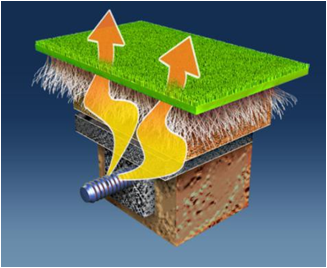
Activating the pressure mode enables injection of fresh air into the root zone. The system applies pressure to force air from the subsoil pipes to the root zone. This provides aeration while moderating temperature in the root zone.
Turf aeration helps prevent such diseases, resulting in stronger and more resilient turf that recovers quickly after every game, thereby, allowing more games to be conducted.
During concerts or other events requiring temporary covering of the surface, turf managers who use the SubAir® Sport system are able to utilise the pressure mode, thereby ensuring a constant supply of air to the root zone.
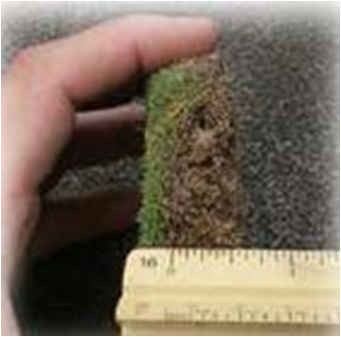
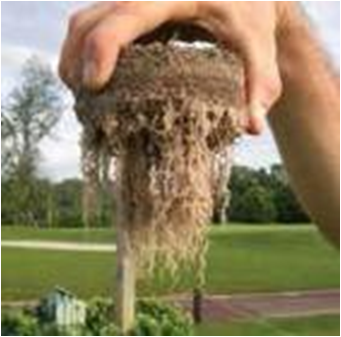
Vacuum Mode
Rain is obviously an “act-of-God” but taking hours (as is the case now) to dry the outfield, while still leaving the spectators and TV audience unsure if/when the game will resume, this results in the loss of TV audience; indirectly causing losses to the advertisers/sponsors.
In a 21st century cricket field, the minimum expectation by all stakeholders is that when the rain subsides, the game will resume within minutes. And this is ensured by SubAir® technology.
Normal drainage systems, which work purely on gravity, are woefully inadequate to evacuate massive amounts of water rapidly. The SubAir® system starts draining surface water the minute it starts to rain, so that rain water is continuously drained with massive power.
The key benefits vacuum mode affords, include:
- Enables rapid resumption of matches
- Facilitates excess moisture removal from the root zone
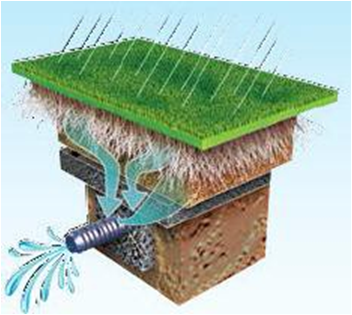
The vacuum mode creates a downward movement of air through the soil and aggregate profile. Activating the vacuum mode allows the turf manager to remove surface water in a short amount of time, to remove non-capillary water from the soil profile, thus ensuring optimal levels of moisture in the root zone with data from the moisture sensors.
TurfWatch
The SubAir® system is automated based on data received from the field through the monitoring and control system. TurfWatch receives and reports soil data (salinity, moisture, and temperature) via wireless sensors placed at critical positions within the soil profile throughout the field. The data then prompts the SubAir® system to perform according to the levels and parameters set by the turf manager. Every operation of the system is fully automated and accessible through an internet connection or wireless device. Oxygen sensors are also placed in suitable locations to ensure the necessary amount is being supplied to the root zone.
USGA Style
The SubAir® Sports System needs a compatible sub-base to function i.e., any outfield/play area that has a sub-base comprising of graded clay-free sand and a gravel profile, with a network of perforated drain pipes. These are similar to a USGA or California Green sub-base. This allows the air to be pumped through the gravel and sand layers to reach the root zone and also allows the water to be suction drained through this profile and channeled to a single point.
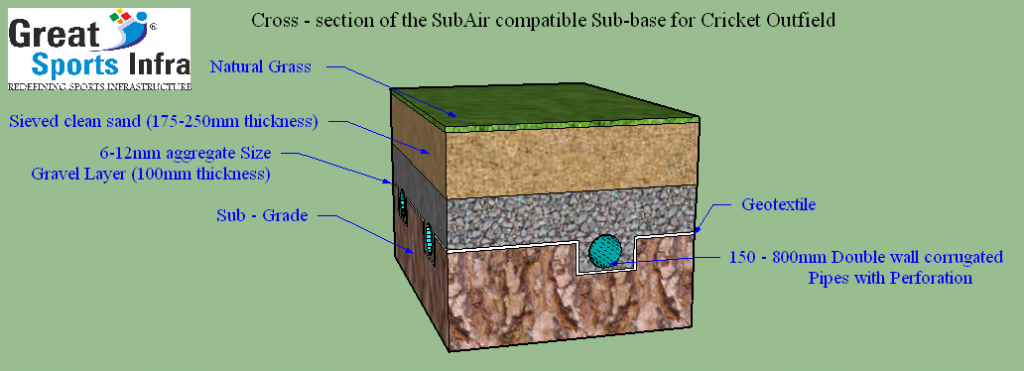
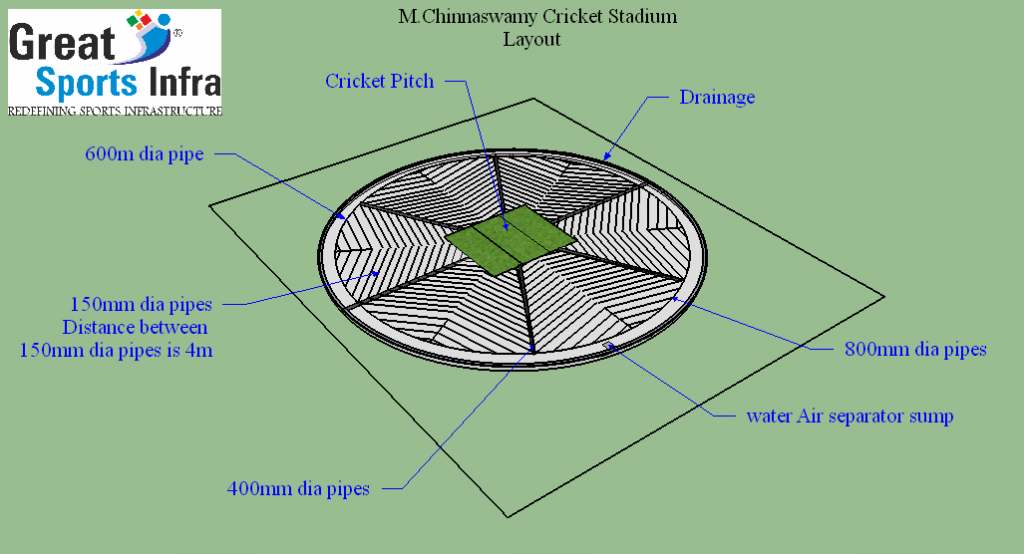
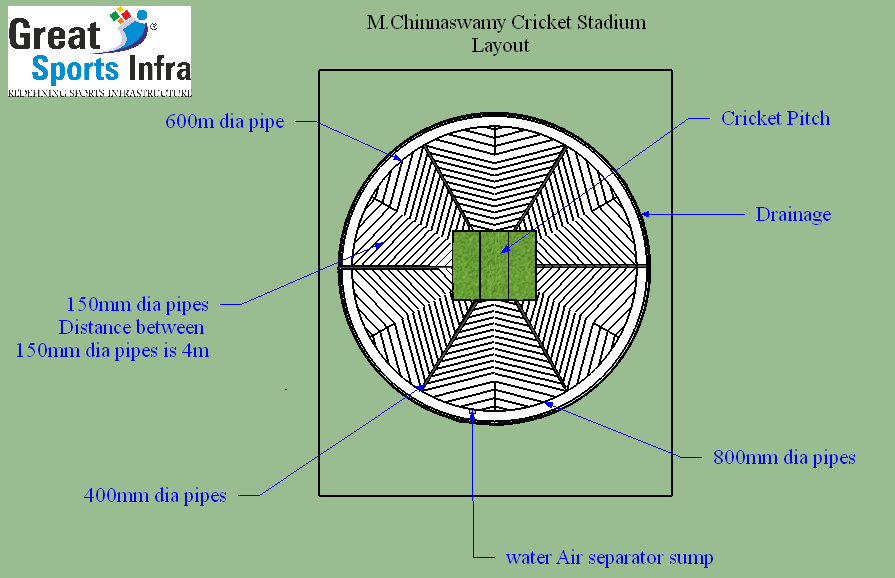
An “Air-Water chamber” is the convergence point, wherein an “air-water separator” redirects the water to the storm water sewers or to the rain water harvesting tank; and the air is expelled out by the reversing valve of the SubAir® System.
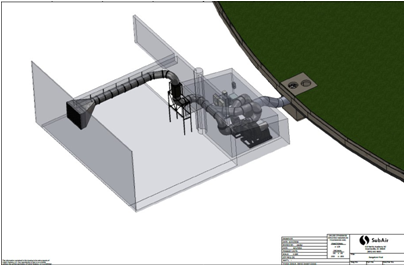
Case Study of Chinnaswamy Stadium Installation
Great Sports Infra (http://greatsportsinfra.com/) recently supplied and installed the SubAir® Sport System at Chinnaswamy Stadium in Bengaluru, India, one of the busiest cricket stadiums in the world.
As ‘home’ to the Karnataka State Cricket Association (KSCA), Chinnaswamy – like many other prominent cricket stadiums in the world – occasionally suffered from matches being delayed or cancelled due to a wet outfield. This not only caused significant losses to the Association, but also to the spectators, the TV right owners, in stadia advertisers, sponsors etc.
With a view to address this problem and to leapfrog to a 21st century cricket outfield, KSCA officials decided to install the SubAir® Sport System.
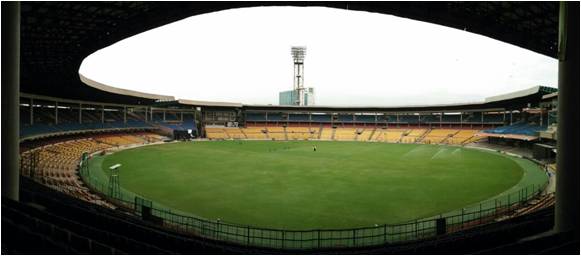
KSCA Hon. Vice President, Mr Sudhakar Rao, said:
This is KSCA’s latest project in our constant endeavour to introduce cutting-edge technologies in the interest of the game and the fans. Everyone understands that when it rains, it is an act of God… but once it stops raining, it will be inexcusable to delay or cancel a game due to a wet outfield. With this high-tech solution from SubAir, fastest resumption of the game is now possible.
KSCA Vice President, Mr Sanjay Desai, added:
Fan experience is our primary objective. Additionally, there is a risk of Rs.80-100 Crores (US$12-15M) when a game gets washed out including losses to the paying public, the TV broadcasters and advertisers, in-stadia advertisers, etc. We believe we have addressed this challenge with the SubAir System.
Spokesperson for the KSCA, Mr Vinay Mruthyunjaya, said:
This technology makes tremendous economic and financial sense for KSCA and many games will be saved in the future.
The ESPN link below includes an overview of the system and a brief case study:
The Wisden coverage encompasses a 1-minute video of a demonstration performed after installation: http://www.wisdenindia.com/cricket-news/chinnaswamy-drainage-gets-state-of- the-art-makeover/235039
Work in progress pictures at the M. Chinnaswamy Stadium
Excavation Phase:
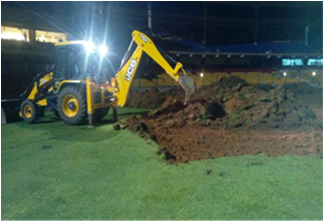
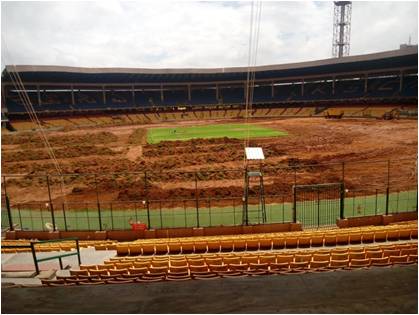
Pipe Laying Phase:
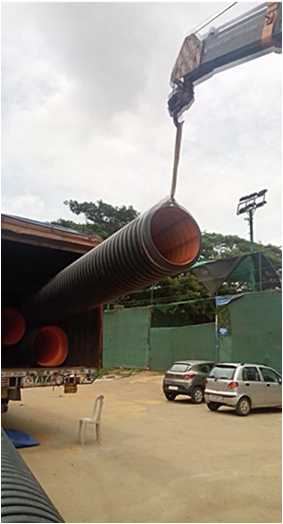
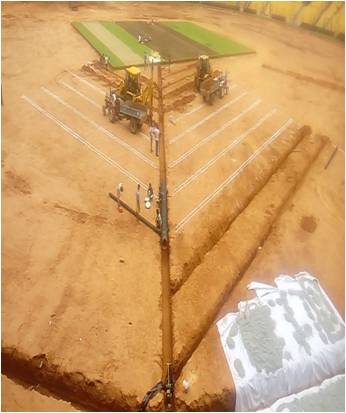
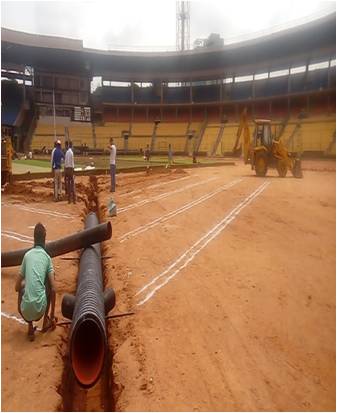
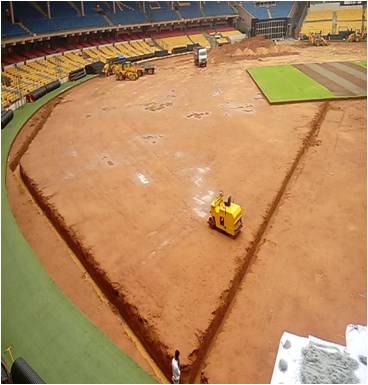
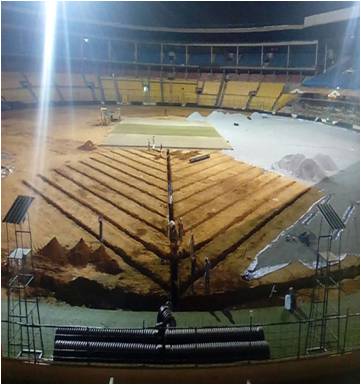
Gravel Laying Phase:
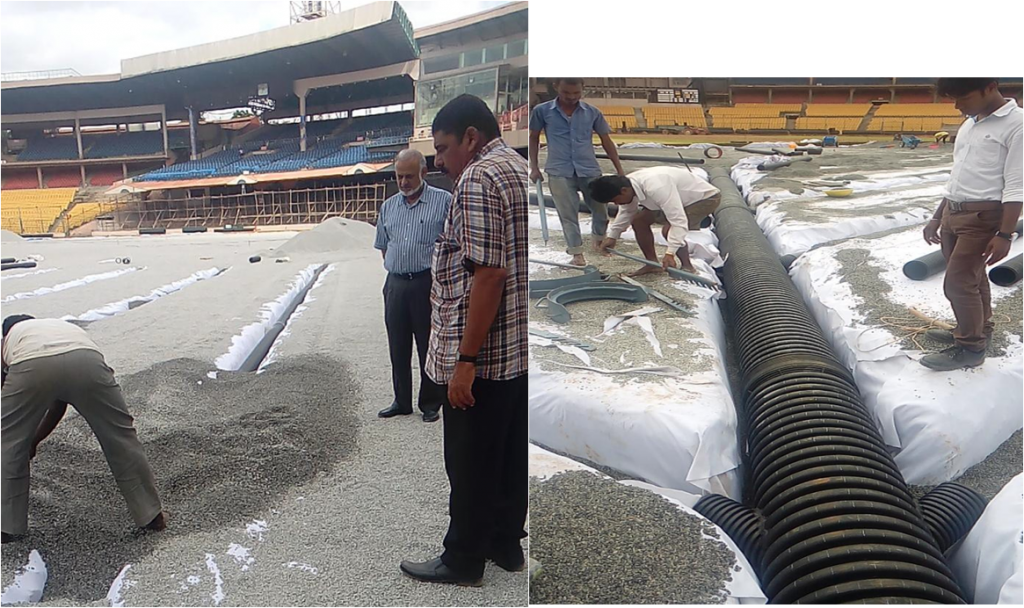
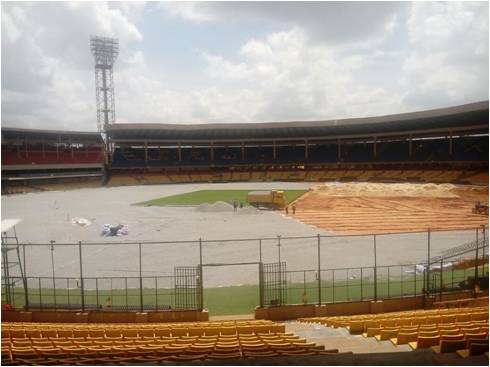

Sand Laying Phase:
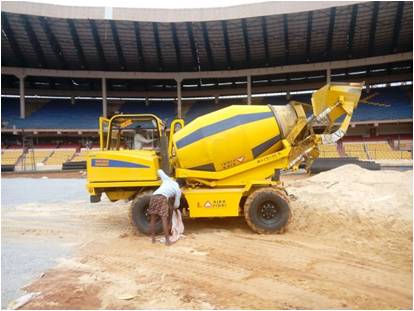
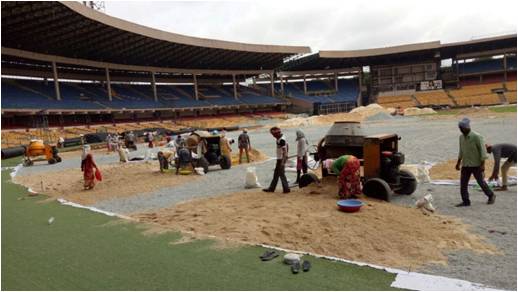
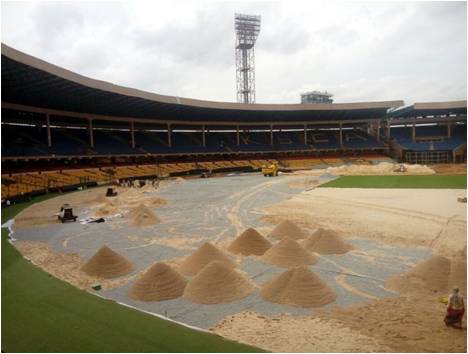
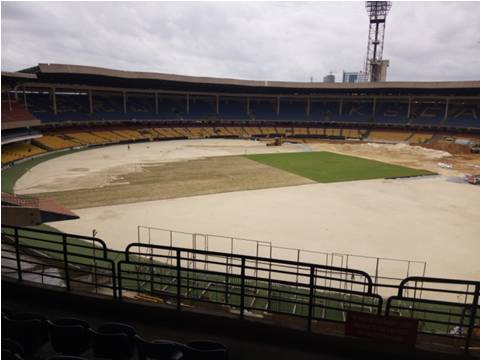
Grass Dibbling Phase:

The SubAir Hydronics System:
SubAir systems have another feature, the Hydronics system that will be very useful in the Sports world. The Hydronics system can provide heating or cooling to maintain ideal root zone temperatures. When in operation, the system allows warm or cool fluid to be pumped from the holding tank to the field via a supply pipe. The fluid then circulates under the root zone of the field through a network of flexible tubing. The working fluid is then returned to the holding tank. The Hydronics system is capable of achieving a temperature drop/increase of 17°C (30°F) in the soil.
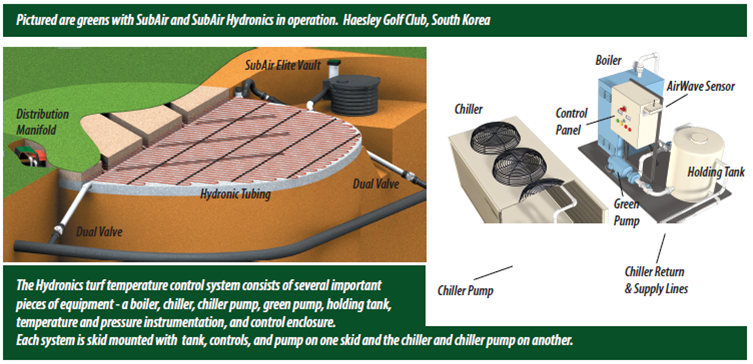
SubAir TurfBreeze:
Solar heat and still air can have a devastating effect on turfgrass. Developed to provide airflow on the surface of sports fields, TurfBreeze is the most respected name in surface aeration. Promoting a healthier turf environment through improved air circulation and the alleviation of heat stress are the primary reasons most Turf managers use Fans for their fields.
When a field’s subsoil temperature reaches high levels, turfgrass roots begin to shrink, diminishing the quality of the playing surface. Fan use can lower the surface temperature of a field up to 10° Fahrenheit, which in turn, lowers the soil temperature approximately 4° to 6° F. Fan use increases turfgrass transpiration, cooling the plant internally and keeping it healthier overall. As an added benefit, TurfBreeze fans can be used to evaporate excess moisture from heavy morning dew. Although thinning trees works best, fans have shown to improve the quality of shaded fields. TurfBreeze will assist you in planning fan size, quantity, and placement to best suit the needs of your field.
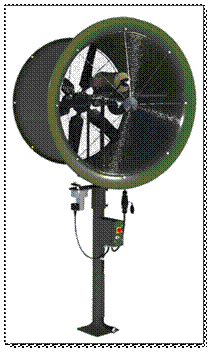
For further information, email: info@greatsportsinfra.com or visit the website at: www.greatsportsinfra.com
#SportsVenueBusiness – keeping you in the know

